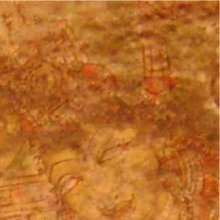Shronisutra, Shroni-sutra, Śroṇīsūtra, Śroṇisūtra: 4 definitions
Introduction:
Shronisutra means something in Hinduism, Sanskrit. If you want to know the exact meaning, history, etymology or English translation of this term then check out the descriptions on this page. Add your comment or reference to a book if you want to contribute to this summary article.
The Sanskrit terms Śroṇīsūtra and Śroṇisūtra can be transliterated into English as Sronisutra or Shronisutra, using the IAST transliteration scheme (?).
Images (photo gallery)
In Hinduism
Natyashastra (theatrics and dramaturgy)
Source: Wisdom Library: Nāṭya-śāstraŚroṇīsūtra (श्रोणीसूत्र) refers to “girdles” and is classified as bandhanīya, or “ornaments that are to be tied up”, according to Nāṭyaśāstra chapter 23. Bandhanīya is one of the four types of ornaments (ābharaṇa). Śroṇīsūtra is composed of the Sanskrit words śroṇī (hips, loins) and sūtra (line, cord).
Ābharaṇa (‘ornaments’, eg., śroṇīsūtra) is a category of alaṃkāra, or “decorations”, which in turn is a category of nepathya, or “costumes and make-up”, the perfection of which forms the main concern of the Āhāryābhinaya, or “extraneous representation”, a critical component for a successful dramatic play.

Natyashastra (नाट्यशास्त्र, nāṭyaśāstra) refers to both the ancient Indian tradition (shastra) of performing arts, (natya—theatrics, drama, dance, music), as well as the name of a Sanskrit work dealing with these subjects. It also teaches the rules for composing Dramatic plays (nataka), construction and performance of Theater, and Poetic works (kavya).
Languages of India and abroad
Sanskrit dictionary
Source: DDSA: The practical Sanskrit-English dictionaryŚroṇisūtra (श्रोणिसूत्र) or Śroṇīsūtra (श्रोणीसूत्र).—
1) a string worn round the loins.
2) a swordbelt; श्रोणिसूत्रं च खड्गं च विमलं कमलेक्षणः (śroṇisūtraṃ ca khaḍgaṃ ca vimalaṃ kamalekṣaṇaḥ) Rām.7.6.65.
Derivable forms: śroṇisūtram (श्रोणिसूत्रम्), śroṇīsūtram (श्रोणीसूत्रम्).
Śroṇisūtra is a Sanskrit compound consisting of the terms śroṇi and sūtra (सूत्र).
Source: Cologne Digital Sanskrit Dictionaries: Monier-Williams Sanskrit-English Dictionary1) Śroṇisūtra (श्रोणिसूत्र):—[=śroṇi-sūtra] [from śroṇi > śroṇa] n. a string worn round the loins, [Mahābhārata]
2) [v.s. ...] a sword-belt, [ib.]
3) Śroṇīsūtra (श्रोणीसूत्र):—[=śroṇī-sūtra] [from śroṇī > śroṇa] n. a string worn round the loins, [Rāmāyaṇa]
[Sanskrit to German]
Sanskrit, also spelled संस्कृतम् (saṃskṛtam), is an ancient language of India commonly seen as the grandmother of the Indo-European language family (even English!). Closely allied with Prakrit and Pali, Sanskrit is more exhaustive in both grammar and terms and has the most extensive collection of literature in the world, greatly surpassing its sister-languages Greek and Latin.
See also (Relevant definitions)
Partial matches: Shroni, Sutra.
Query error!
Full-text: Shroniphala, Bandhaniya, Katakahasta.
Relevant text
Search found 4 books and stories containing Shronisutra, Shroni-sutra, Śroṇī-sūtra, Sroni-sutra, Śroṇi-sūtra, Śroṇīsūtra, Sronisutra, Śroṇisūtra; (plurals include: Shronisutras, sutras, sūtras, Śroṇīsūtras, Sronisutras, Śroṇisūtras). You can also click to the full overview containing English textual excerpts. Below are direct links for the most relevant articles:
Cosmetics, Costumes and Ornaments in Ancient India (by Remadevi. O.)
2.7. Various other Waist Ornaments < [Chapter 3 - Ornaments]
2.2. Various other Ear Ornaments < [Chapter 3 - Ornaments]
Markandeya Purana (Study) (by Chandamita Bhattacharya)
Types of Ornaments < [Chapter 2]
Pallava period (Social and Cultural History) (by S. Krishnamurthy)
Ear Ornaments (Karnabhushana) < [Chapter 4 - Material Culture of the People]
Conclusion (Material Culture) < [Chapter 5 - Conclusion]
Natyashastra (English) (by Bharata-muni)
